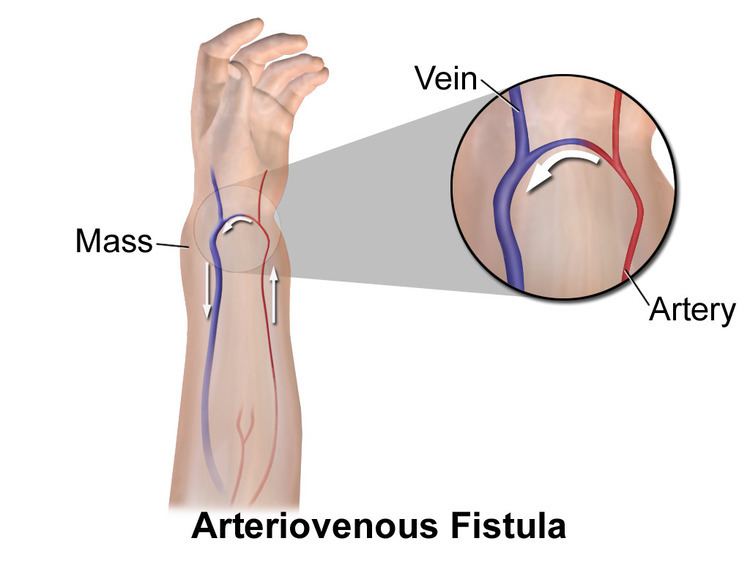Specialty cardiology DiseasesDB 32435 MeSH D001164 | ICD-10 I28.0, I77.0 eMedicine med/169 | |
 | ||
ICD-9-CM 414.19, 417.0, 447.0, 747.3 | ||
An arteriovenous fistula is an abnormal connection or passageway between an artery and a vein. It may be congenital, surgically created for hemodialysis treatments, or acquired due to pathologic process, such as trauma or erosion of an arterial aneurysm.
Contents
Causes
Associated conditions
Complications
Just like berry aneurysm, an intracerebral arteriovenous fistula can rupture causing subarachnoid hemorrhage.
Mechanism
When an arteriovenous fistula is formed involving a major artery like the abdominal aorta, it can lead to a large decrease in peripheral resistance. This lowered peripheral resistance causes the heart to increase cardiac output to maintain proper blood flow to all tissues. The physical manifestations of this would be a relatively normal systolic blood pressure with a decreased diastolic blood pressure resulting in a wide pulse pressure.
Normal blood flow in the brachial artery is 85 to 110 milliliters per minute (mL/min). After the creation of a fistula, the blood flow increases to 400–500 mL/min immediately, and 700–1,000 mL/min within 1 month. A bracheocephalic fistula above the elbow has a greater flow rate than a radiocephalic fistula at the wrist. Both the artery and the vein dilate and elongate in response to the greater blood flow and shear stress, but the vein dilates more and becomes "arterialized". In one study, the cephalic vein increased from 2.3 mm to 6.3 mm diameter after 2 months. When the vein is large enough to allow cannulation, the fistula is defined as "mature".
An arteriovenous fistula can increase preload. AV shunts also decrease the afterload of the heart. This is because the blood bypasses the arterioles which results in a decrease in the total peripheral resistance (TPR). AV shunts increase both the rate and volume of blood returning to the heart.
